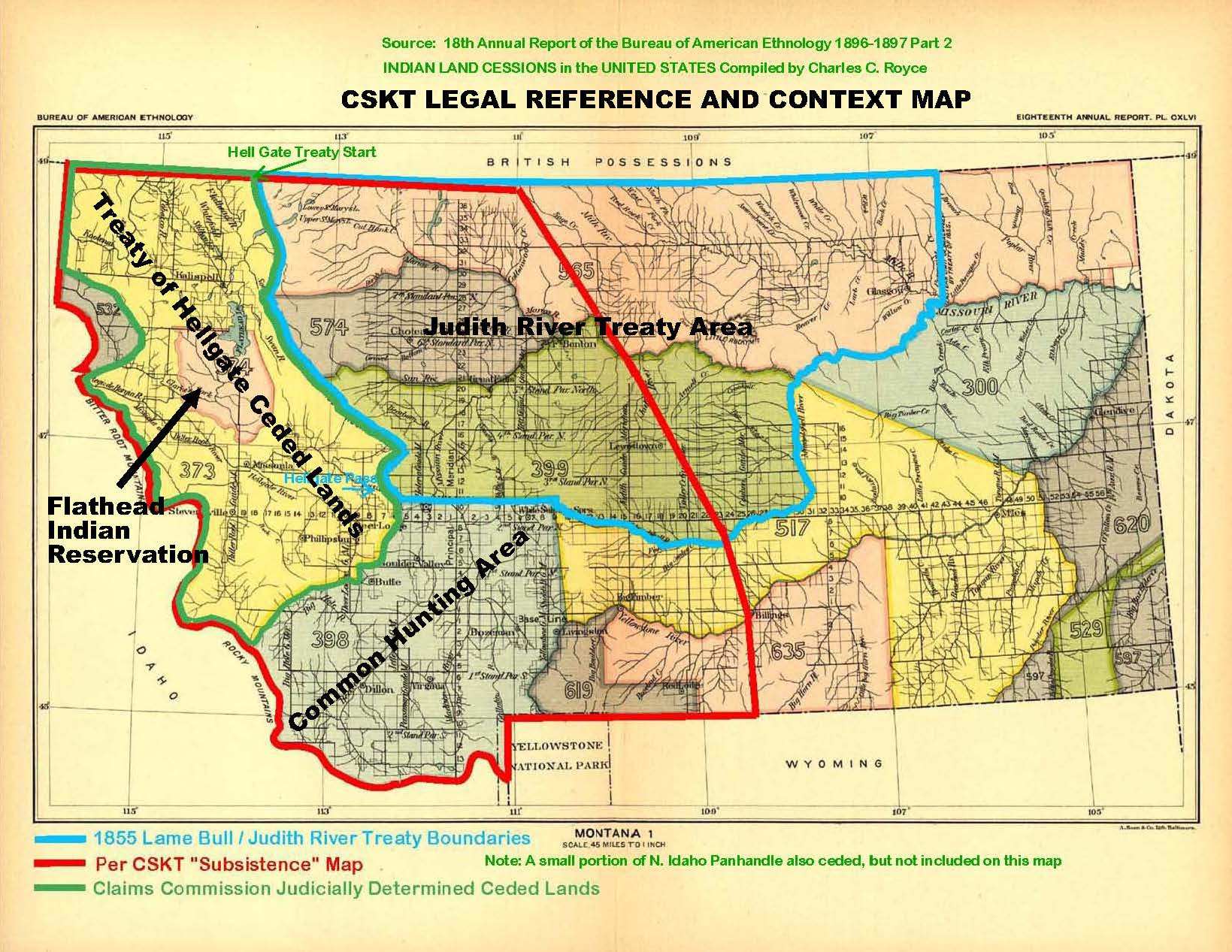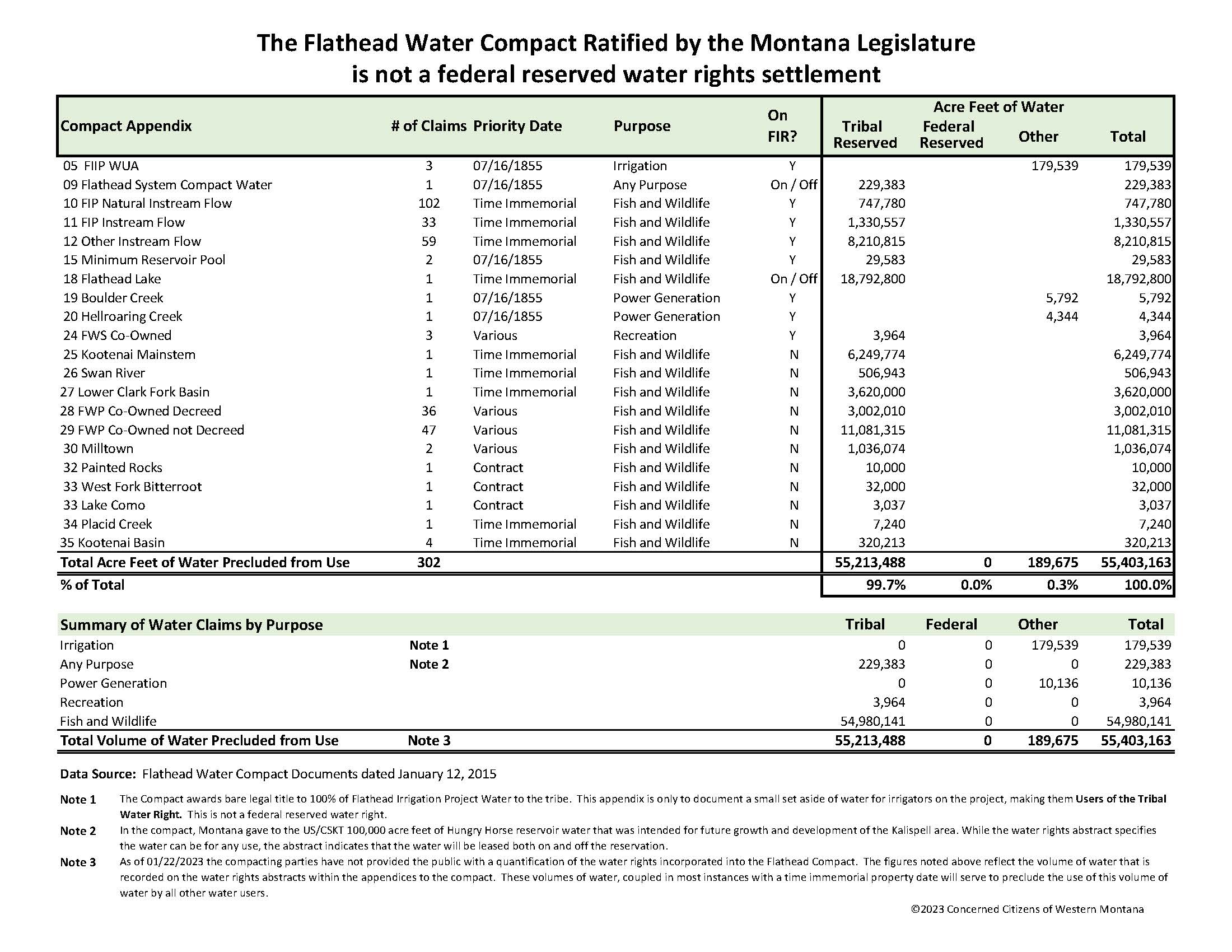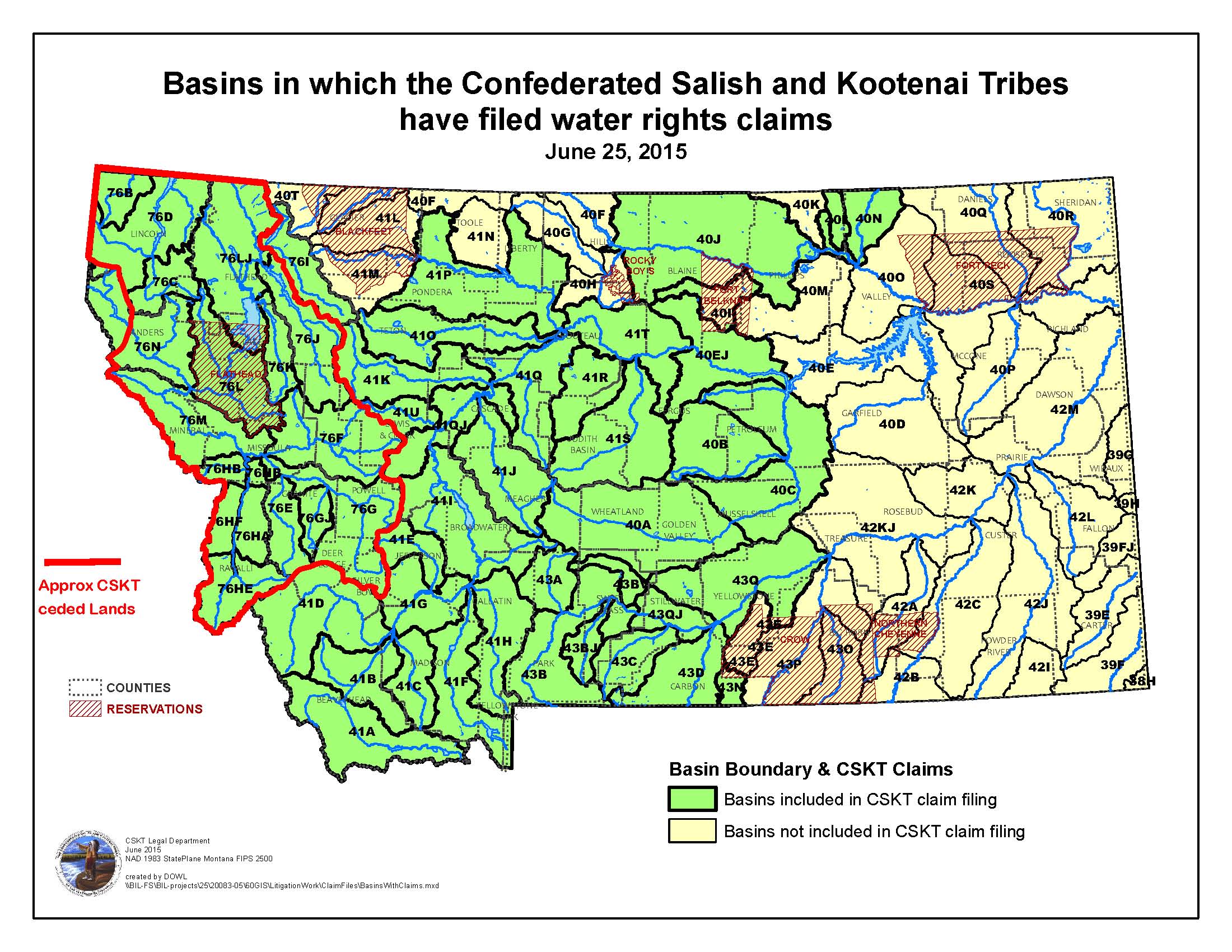© 2023 Concerned Citizens of Western Montana
In 2015 we compiled a video on behalf of the Montana Land and Water Alliance titled Hidden War.
It pointed out that the goal of the CSKT is not only to go after the ownership and control of all Flathead Reservation lands, but also their ceded, and already paid for “territory.”
For those of you unfamiliar with this issue, the tribe’s ceded lands cover most of western Montana.
For the United States and CSKT, there is no getting around the fact that Article VI of the Hellgate Treaty provided for allotments of land to individual Indians and the federal opening of the reservation to settlement. The United States fulfilled those provisions of the treaty in the early 1900’s.
In 2023, 85% of the population located within the reservation’s historic boundaries are non-Indian, living on privately owned fee land. Many residents in this area have family members that are tribal, or are considered to be tribal descendants.
The Flathead Compact, currently being judicially reviewed by the Montana Water Court, has very effectively been used by the compacting parties as a means to reverse that history. If it is allowed to stand, the land patents issued to Indian allottees and everyone else will ultimately become meaningless pieces of paper.
In 2023 the war for western Montana is even more intense than it was just eight years ago. The ratification and ongoing implementation of the Flathead Water Compact federalizes our water and effectuates a massive transfer of wealth from the people of Montana to the United States / CSKT.
It is quite clear that the compact shifted the momentum, creating great uncertainty concerning our water. Because the compact has not yet reached its “enforceability date,” the brunt of the compact’s effects cannot yet be seen or experienced.
Back then we discussed the fact that if you control the water, you control the people as well as the productivity and value of the land. In 2015, we conveyed that the assault on the ownership of private property was being waged on multiple fronts, with the intent to acquire land and water in western Montana including:
- A BIA / tribal take over the Flathead Irrigation Project
- The purchase and takeover of Kerr Dam
- Using Bonneville Power mitigation funds to acquire lands and conservation easements along waterways both on and off the reservation.
- Using federal government “settlement” funds to purchase and “consolidate” fractionalized lands
- A 2014 federal lawsuit declaring ownership of all the land and water within reservation boundaries
- The Flathead Water Compact proposing to give the tribe and united states control over the abundant water in western Montana
It’s now several years later and we’d like to expand the list to discuss some of the weapons now being used to advance this goal even further along. While the original list included actions taken by the CSKT tribes with the help of the United States, our expanded list speaks to the efforts of the three collusive compacting party governments: the State of Montana, the United States, and the CSKT:
- Ratifying a “federal reserved water rights” settlement that does not include any federal reserved water rights, It is a fact that the compact awards to the United States / CSKT far more water than exists in western Montana (for fish and wildlife), yet not a drop of it was set aside for the needs of individual tribal members.
- Ensuring that the water compact provides no finality by adding provisions to dismiss the tribes’ claims “without prejudice.” Never ending legal chaos has been a very successful strategy for the U.S. and the tribes.
- Establishing a jurisdictional crisis scenario by creating tribal reserved water rights out of thin air, with the knowledge that by definition, the state and very likely the United States cannot have jurisdiction over them. This leaves a jurisdictional void that CSKT will be more than happy to fill.
- Federalizing state wildlife and natural resource agencies and funding them with federal money that is used for government land acquisitions and conservation easements on millions of acres of Montana lands. This not only limits the productivity of those lands, but also removes them from private ownership.
- Expanding the battle to cover 2/3 of the state by filing 10,000 water rights claims, and somehow getting Montana to allow them to “eventually be dismissed without prejudice.” This establishes a pathway for generations of tribal litigation and monetary settlements in the future.
It is now abundantly clear that for some yet unknown reason, Montana is fully on board to help the United States and CSKT achieve their goal to restore western Montana back to the United States tribes. As if the compact overreach the state agreed to wasn’t enough, Montana’s treatment of the 10,000 water rights claims filed by the U.S / CSKT in June of 2015 indicates that they may also be willing to help the United States, via the CSKT, expand its reach to gain significant influence and control over 2/3 of the state.
Three Predatory Governments working toward the same end
Predatory behavior refers to actions that involve plundering, pillaging, or marauding, with the intention of injuring or exploiting others for personal gain or profit.
Clearly the compacting parties achieved an agreement that will serve to plunder all of the people in Montana. By agreeing to the compact, Montana consented to a massive transfer of wealth away from the state and its citizens, and into the hands of the United States and CSKT.
The compact:
- Plunders the state and federal treasuries through the massive monetary settlements of the state and the feds to a federally chartered tribal corporation government.
- Federalizes and transfers ownership of vast amounts of state-owned water to the U.S. / CSKT. This effectively transfers billions if not trillions of dollars, diminishes the economic wealth of western Montana, and prohibits future development.
- Attempts to deprive Montanans of their due process and equal protection under the law.
- Destroys the water and property rights of Montana citizens, effectively relegating them to owners of land without water, and mere “users of the tribal water right”
- Cedes Montana’s jurisdiction over water within Flathead Reservation boundaries despite the fact that 80% of the people live on private fee lands that are taxed by the state.
When you have predatory governments that are willing to sacrifice their citizens’ due process and other constitutional protections, and to jeopardize or impede the ownership of private property, you have to know you are in serious trouble.
Is the Compact the beginning of the end of government as we know it?
Collapsing the state and local government systems that are currently in place would necessarily be an outcome of any plan to restore western Montana’s land mass to the United States tribes. What is so insidious about this is that such a collapse of government occurs over a very long period of time, one successful agreement, one ill advised state or federal law, one unconstitutionally decided court case, and one consensual agreement or memorandum of understanding at a time.
This cancerous effect is well underway within the reservation boundaries, and it is only a matter of time before Flathead and Sanders counties will also feel its effects if they aren’t already. It is a fact that Bonneville Power land acquisitions, cloaked under the guise of “mitigation settlements,” are taking place in Flathead and Sanders counties converting ownership of off reservation lands along very important waterways to the CSKT, or in some instances even to state government entities.
There is little doubt that from there it will expand elsewhere.
With land and water rights already in jeopardy via the compact, it is highly likely the property tax base will take a nosedive as property values decline. We are positive that Lake County is already feeling the affects of the Bonneville land acquisitions as well as the land consolidation program to convert lands into tribal trust where they are not subject to taxation.
Conservation easements are also moving this goal along at an astounding pace, to the tune of hundreds of thousands of acres in western Montana. The United States, Montana and its wildlife and natural resource agencies, the CSKT, and environmental groups are working in concert to diminish the productivity of Montana’s land by imposing perpetual conservation easements upon them. All of these land acquisitions by state and federal government, coupled with the addition of conservation easements has a calculable, negative effect on the tax base as well.
If the tribe uses any of its new found “settlement” wealth to make trust acquisitions of water compact devalued land, the tax base will diminish even further.
Combined, all of these directional shifts could have the effect of depriving our local governments of the tax money needed to provide necessary services.
County Government
Over the past several years, we’ve heard rumblings from the Lake County Commissioners that if things keep going the way they are the County will be bankrupt in a decade. This could effectively split the county placing the northern part in Flathead County and the southern portion of the county would go to (oh the horror of it) Missoula County.
If this happens, Lake County will have gone the way of Browning or Glacier County. These local governments have long been dealing with serious monetary issues due to corruption and aggressions by the Blackfoot Tribes, including the negative effects of tribal infiltration of their county government.
While the Lake County Commissioners are putting up a valiant fight, only time will tell if their predictions of bankruptcy will indeed become a reality.
Flathead Project Irrigation Districts
The Irrigation Districts of the Flathead Irrigation Project are also local governments, and are there to represent the interests of the irrigators whose lands are served by the project. These small irrigation district governments will likely be destroyed in the aftermath of the compact.
After compact proponents took down the Flathead Joint Board of Control in 2014 and the BIA took over operations, their only remaining useful purpose is to be a pass through of Operations and Management fees to the Bureau of Indian Affairs and the Tribe.
Irrigators no longer have a say in project operations despite the fact that 90% of the lands served by the project are privately owned. Because the compact gives the CSKT ownership of 100% of the project water, the BIA / CSKT will be the enforcers of the “tribal water right” via the Flathead Unitary Water Management Board.
Unitary by the way does not mean one water management entity working in the best interests of all water rights holders and users. As per the tribe’s 2001 proposal to the state, it is effectively intended to be a unitary or single focus entity, established for the purpose of protecting the tribes’ water rights.
Since 2004, the compacting parties have focused a significant part of their efforts on the development of a comprehensive Reservation-wide Tribal water administration ordinance, which will apply the (time immemorial) seniority system and protect the unique federal attributes of Indian reserved and aboriginal rights.
In Closing
Can you see how the compact and the 10,000 claims help create a pathway to wreak havoc throughout western Montana?
If Montana was willing to cede its jurisdiction over water within reservation boundaries, what other constitutionally mandated responsibilities might it cede next in deference to United States tribal governance and control?
If the compact and its tribal reserved water rights survive, the Kootenai and Clark Fork regions will very likely become the subject of many lawsuits to enforce the tribe’s water rights and to protect water quality throughout western Montana. If not lawsuits, we can easily see that the Montana DNRC, proven to be tribal and federal advocates, will become the off-reservation enforcer of the tribal water rights.
If the 10,000 claims are adjudicated via the Turtle Mountain / Little Shell Roadmap as articulated in the state’s brief to the water court in December 2022, ALL BETS ARE OFF.
Let’s see if we get this right. If the billionaires funding the American Prairie Reserve gain control and ownership of far eastern Montana, and Montana offers a pathway to the water compact and 10,000 claims covering the other 2/3 of the state, exactly what will ultimately be left for the likes of our “esteemed Governor Greg” to govern?
Trouble is brewing in Montana and it starts and ends with our State government, and the United States / CSKT.

Thanks to a local resident for sharing this photo taken in the Mission Valley on May 10, 2023.
Why in the world would Montana willingly unleash all of this angst and lawlessness upon its citizens?
Something very fishy is going on in Montana.
And we better figure out what it is before there is no turning back.




Excellent information, thank you!!!!
Pingback: Destructive Ends: Transfers of Wealth via Federal Infrastructure | Western Montana Water Rights